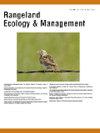No Field Evidence of Grass Fuel Structure effects on Postfire Tree Mortality in Juniperus virginiana
IF 2.4
3区 环境科学与生态学
Q2 ECOLOGY
引用次数: 0
Abstract
Prescribed fires are an important management tool for containing woody plant encroachment in rangeland ecosystems. Grasses are the dominant fuel type in rangelands. Past work has shown that grass canopy architecture, which varies among grass species, can influence flammability. Whether variation in grass fuel structure can influence postfire plant responses has not yet been tested. To bridge this gap, we set up field burning experiments with different fuel treatments and examined postfire mortality of Juniperus virginiana L. in a tallgrass prairie in southwestern Missouri. We sampled 60 trees and measured tree height and diameter at breast height before the fire. Fuels surrounding each tree were manipulated to vary independently in both fuel load and fuel structure. Flame temperatures were measured during the fire, and both stem and canopy injuries were evaluated 1 d after the fire. We surveyed tree mortality 7 mo after the fire. We found no effects of either fuel load or fuel structure on postfire mortality or on canopy injury in J. virginiana. Canopy injury was a critical fire severity measurement determining postfire mortality in J. virginiana, and taller trees are more fire resilient. Despite laboratory-observed fuel structure effects on flammability, this study finds no evidence for the importance of grass fuel load and canopy architecture in influencing postfire tree response. This result might arise from the low crown depth and low canopy water content of J. virginiana, which can promote canopy fire and result in a high mortality rate across fuel treatments. Notwithstanding the negative results, testing laboratory-based findings in field settings is important for further examining laboratory observations and upscaling individual-level processes to ecosystems to help identify the key ecological processes determining population dynamics and community assembly. Our study also suggests that prescribed fire is an effective tool to remove encroaching J. virginiana in tallgrass prairies at an early stage.
没有实地证据表明草燃料结构对杜松火后树木死亡率有影响
预设火种是遏制木本植物侵占牧场生态系统的重要管理工具。草是牧场的主要燃料类型。过去的研究表明,不同草种的草冠结构会影响可燃性。至于草地燃料结构的变化是否会影响植物的火后反应,目前尚未进行过测试。为了弥补这一空白,我们在密苏里州西南部的高草草原上进行了不同燃料处理的野外燃烧实验,并考察了L.的火后死亡率。我们对 60 棵树进行了取样,并在火灾前测量了树高和胸径。我们对每棵树周围的燃料进行了处理,使其在燃料负荷和燃料结构方面各不相同。火灾期间测量了火焰温度,火灾 1 d 后评估了茎干和树冠的损伤情况。火灾发生 7 个月后,我们对树木死亡率进行了调查。我们没有发现燃料负荷或燃料结构对火灾后树木死亡率或树冠损伤有任何影响。树冠损伤是火灾严重程度的一个重要衡量标准,它决定了Ⅳ级飓风的火后死亡率,而高大的树木在火灾中的抗灾能力更强。尽管实验室观察到燃料结构对可燃性有影响,但本研究没有发现任何证据表明草地燃料负荷和树冠结构对火后树木反应的重要影响。造成这一结果的原因可能是Ⅳ级草地的树冠深度低、冠层含水量低,这可能会促进冠层着火并导致各种燃料处理的高死亡率。尽管结果是负面的,但在野外环境中检验基于实验室的研究结果对于进一步研究实验室观察结果和将个体水平的过程放大到生态系统非常重要,有助于确定决定种群动态和群落组合的关键生态过程。我们的研究还表明,处方火是一种有效的工具,可以在早期清除高草草原上的蚕食物种。
本文章由计算机程序翻译,如有差异,请以英文原文为准。
求助全文
约1分钟内获得全文
求助全文
来源期刊

Rangeland Ecology & Management
农林科学-环境科学
CiteScore
4.60
自引率
13.00%
发文量
87
审稿时长
12-24 weeks
期刊介绍:
Rangeland Ecology & Management publishes all topics-including ecology, management, socioeconomic and policy-pertaining to global rangelands. The journal''s mission is to inform academics, ecosystem managers and policy makers of science-based information to promote sound rangeland stewardship. Author submissions are published in five manuscript categories: original research papers, high-profile forum topics, concept syntheses, as well as research and technical notes.
Rangelands represent approximately 50% of the Earth''s land area and provision multiple ecosystem services for large human populations. This expansive and diverse land area functions as coupled human-ecological systems. Knowledge of both social and biophysical system components and their interactions represent the foundation for informed rangeland stewardship. Rangeland Ecology & Management uniquely integrates information from multiple system components to address current and pending challenges confronting global rangelands.
 求助内容:
求助内容: 应助结果提醒方式:
应助结果提醒方式:


